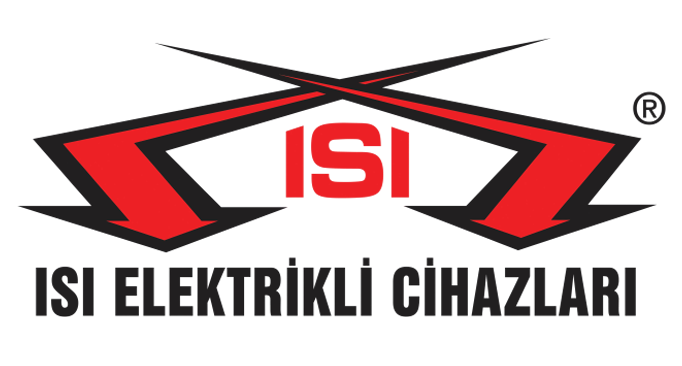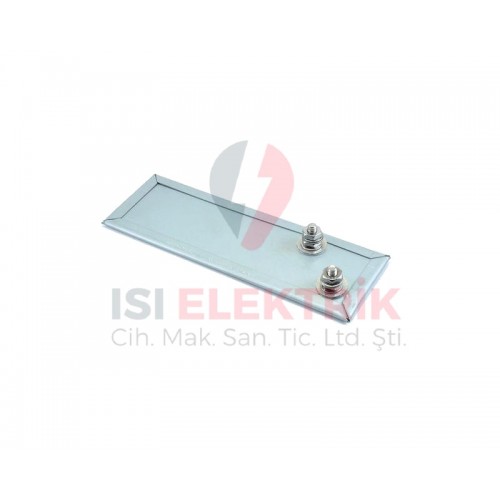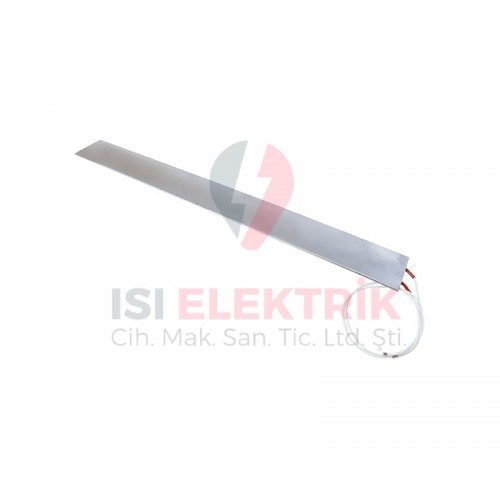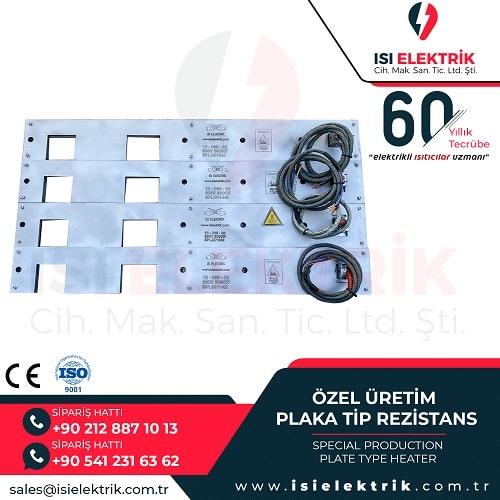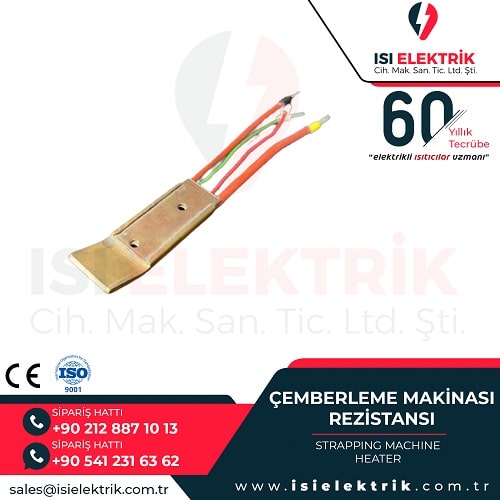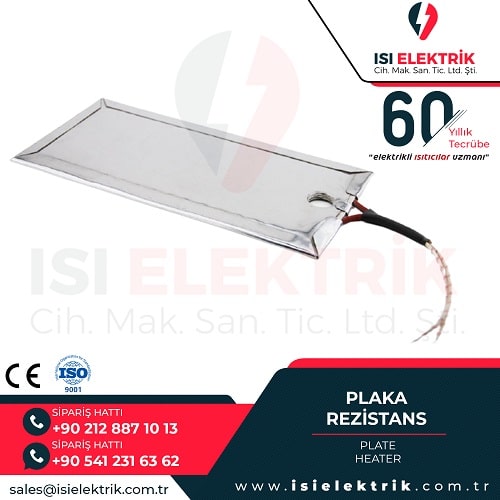Mica Heaters
Plate Type Heaters
Plate-type heaters are industrial heating system components. These heaters are appropriate for watt-based operations in industrial areas such as injection and mold heating. These products are used for high-temperature performance. It can be used both at home and in the workplace.
These heaters help in eliminating issues that may arise in manufacturing heating systems. They are high-tech heater materials made of high-efficiency chrome-nickel wire or copper plate. These goods are used in the heating of mold presses all over the world, including our own. Our company manufactures special plate type heaters for a variety of needs.
Call us right now for plate-type heater orders and production, and we will always provide you with detailed information and assistance. We make it as soon as possible and send it to you as quickly as immediately.
Plate Resistor Applications
Plate resistors are primarily used in industrial fields. These products are suitable for applications where mold presses need to be heated, and they play a critical role in various manufacturing processes. They are commonly found in the plastic, rubber, packaging, and textile industries. In the rubber industry, plate resistors are used for heating cutting molds. Additionally, they are used in injection molding machines and also have applications in the textile industry. Moreover, plate resistors are commonly preferred in the automotive industry and its ancillary sectors for various heating and production processes.
Plate resistors have a broad range of applications. Not only are they used in industrial settings, but they are also found in many everyday household appliances. Specifically, mica plate resistors are functional components found in electric household appliances such as water heaters (boilers), ovens, and electric stoves. Due to their high heat resistance and long lifespan, these resistors are widely used in household devices. Furthermore, their compact design ensures that they save space in various appliances while providing efficient heating.
Plate resistors are also used in a variety of industrial machines, laboratory equipment, hot air blowers, drying machines, and other similar applications. These products are preferred in such applications due to their high energy efficiency. Additionally, their durability and reliability allow them to maintain high performance even during long-term operations.
Various plate resistor models can be customized to meet specific heating needs. These products, which provide efficient heating on their own, can also be designed for specialized applications. For example, in industries that require high temperatures, plate resistors are typically used as durable and reliable solutions.
Plate resistors provide versatile and high-performance heating solutions for both industrial and domestic use. With their excellent performance, durability, and wide range of applications, plate resistors hold an essential place in heating applications.
Plate Type Heaters Technical Specifications
• Plate type heaters are products used in industrial heating systems.
• These goods can perform at temperatures up to 800
degrees.
• They are produced by wrapping 60/15-80/20
nickel-chrome wire on high purity mica.
• These items are also plated with stainless steel or
copper.
• Plate type heaters are also available with screw,
terminal, plug, and cable outlet options depending on the purpose.
• If up to 3.5 watts per centimeter are to be produced
in plastic injection and mold heating systems, it can be produced in sizes and
values that meet your specifications.
• Plate type heaters with higher wattages are also
available. Ceramic plate-type heaters can be manufactured in this case. In this
case, the production that is efficient up to 6 watts of power can be made.
• We can manufacture plate-type heaters in any shape you
want. Flat, round, L-type, and U-type connections can be made in these
products. Models with connections in the form of many holes on the surface can
also be produced in these goods.
• Production can be made with different sizes, watts, and features.
You can contact us immediately for plate-type heaters production.
Plate Heater Prices
Plate heater prices vary depending on several factors. Prices are influenced by the materials used, size, technical specifications, and manufacturing process. These elements are key in determining the quality and durability of the heaters. Plate heaters are commonly used in industrial applications and can be customized for different needs. Customizations for specific heating capacities and durability requirements directly impact the price.
We work hard to produce plate heaters at the most competitive prices while maintaining high quality. We focus on providing high-performance, long-lasting, and durable products. We offer a wide range of heaters to meet various needs. The prices of plate heaters may vary based on the materials used. For example, mica plate heaters tend to be more affordable, while heaters made from ceramic or special alloys may be priced higher. However, we always aim to offer the best price-to-performance ratio.
Plate heater prices are directly related to the technologies used and the precision in the manufacturing process. Each heater is carefully manufactured to ensure optimal heating efficiency. We also offer special pricing options and custom quotes for every type of plate heater. For detailed information about products and pricing, please feel free to contact us. Our team will determine the best heater model for your needs and begin production promptly.
For more information about plate heaters, to get a quote, or to place an order, please contact us right away. We can process your orders quickly and securely and begin production immediately. Our prices are kept affordable without compromising quality. We continue to provide tailored solutions for industrial heating needs. Our goal is to provide the best plate heaters at competitive prices and ensure reliable solutions for years to come.
Technical Specifications of Plate Heaters:
- General Specifications:
- Power Range: Various power options ranging from 100 Watts to 3000 Watts.
- Electrical Voltage: Can operate at 220 Volts or 240 Volts.
- Temperature Range: Can be used within various temperature ranges from 50°C to 800°C.
- Body Material: Can be manufactured from different materials such as stainless steel, aluminum, or cast iron.
- Heating Element Material: Various materials such as nickel-chrome, stainless steel, or Inconel are used.
- Protection Class: Can have various protection levels like IP20, IP44, or IP65.
- Connection Type: Different connection options are available such as butterfly nut, cable connection, or plug connection.
- Other Technical Specifications:
- Heating Rate: The ability of the resistor to heat up rapidly.
- Cooling Rate: The ability of the resistor to cool down quickly.
- Heat Distribution: The resistor's ability to distribute heat uniformly.
- Lifespan: How long the resistor can endure.
Mica Insulated Heaters
Mica insulated heaters are commonly used in the plastic industry, particularly in injection molding machines, packaging industries, and for raising plastic raw materials to injectable temperatures. Mica, with its high heat resistance and excellent insulation properties, is an ideal material for such applications. Mica insulated heaters provide high efficiency in heating processes, allowing for precise and safe temperature control in industrial operations.
These heaters do not typically follow a standardized size and can be custom-designed based on specific customer requirements. The dimensions, watt density, power output, and operating temperatures of mica insulated heaters can all be customized. This flexibility makes them suitable for a wide range of industrial applications. The high heat insulation capacity of mica ensures that these heaters maintain durability even at elevated temperatures, enhancing product safety and longevity.
Mica insulated heaters can typically be manufactured with a maximum heating power of up to 3 W/cm². This watt density is ideal for applications like plastic processing and packaging. However, if higher watt densities are required, ceramic insulated heaters should be considered. Ceramic heaters use more heat-resistant materials and can deliver higher heating power, making them more suitable for applications that demand higher watt densities.
Mica insulated heaters are known for their long lifespan and durability. The excellent electrical insulation properties of mica ensure efficient heater operation, minimizing electrical losses. Additionally, mica's resistance to high temperature fluctuations helps maintain stability during temperature changes, ensuring consistent performance. These features also provide significant energy efficiency advantages, as mica insulated heaters offer high performance with lower energy consumption.
In conclusion, mica insulated heaters play an important role in many industrial applications. They are especially reliable and efficient for heating solutions in plastic processing machines, packaging machines, and other industrial processes requiring heat treatment. With customizable designs and high-performance features, these heaters provide a reliable and efficient heating solution for various industrial processes.
Applications of Plate Heaters:
- Metal Processing Industry: Plate resistors are used to meet heating requirements in processes such as shaping, cutting, and welding metal sheets.
- Agricultural Sector: Plate resistors are commonly preferred for greenhouse heating systems and soil heating systems in the agricultural industry.
- Electronics Manufacturing: Plate resistors are used in drying electronic components and soldering processes.
- Paint and Coating Industry: Plate resistors are found in oven and drying systems used for painting and coating metal and plastic surfaces.
- Packaging Industry: Plate resistors are used for shaping and heating plastic, paper, or cardboard packaging materials.
- Home Appliances: Plate resistors are frequently used in heating-based devices in home appliance manufacturing. For instance, plate resistors are found in appliances like ovens, grills, and toasters.
- Drying and Sterilization: Plate resistors are used in drying and sterilization processes for appliances such as washing machines, dishwashers, and medical devices.
Advantages of Plate Heaters:
- Low Maintenance Cost: Plate resistors generally require low maintenance, reducing operating costs.
- Flexible Usage: Plate resistors can operate within a wide temperature range and can be designed to fit various environments.
- Compact Design: Plate resistors usually have a compact and space-saving design, providing space efficiency during installation.
- Ease of Use: Plate resistors are typically easy to control and operate, offering convenience for operators.
- High Efficiency: Plate resistors direct heat to the intended target, minimizing energy loss and ensuring high efficiency.
- Cost-Effectiveness: Plate resistors are generally more cost-effective compared to other heating methods, offering an economical solution for business owners.
Materials Used in Plate Heater Production:
- Body Material:
- Stainless Steel: Durable, corrosion-resistant, and easy to clean.
- Aluminum: Lightweight and corrosion-resistant.
- Cast Iron: Solid and durable.
- Heating Element Material:
- Nickel Chrome: Durable and long-lasting.
- Stainless Steel: Corrosion-resistant and easy to clean.
- Inconel: Resistant to high temperatures and corrosion.
- Insulation Material:
- Ceramic: High temperature resistant and good insulation properties.
- Mica: Flexible and can withstand high temperatures.
- Connection Elements:
- Butterfly Nut: Used to secure the plate resistor to the furnace or heating environment.
- Cable Connection: Used to connect the plate resistor to the power source.
- Plug Connection: Used for convenient connection.
Plate Heaters Features Providing High Heat Efficiency
Plate heaters are widely used in industrial applications due to their features that provide high heat efficiency. These heaters are specifically designed to improve energy efficiency in heating processes and reduce costs. The heat efficiency of plate heaters depends on the quality of the materials used and the design. Below are some key features of plate heaters that contribute to high heat efficiency:
- High Heat Distribution: Plate heaters offer a wide heating surface, allowing for even heat distribution, ensuring temperature balance. This feature helps prevent energy waste and enables a more efficient heating process.
- Quick Heating and Cooling: Plate heaters have rapid heating and cooling properties, allowing processes to be carried out more efficiently and quickly. This is a significant advantage for energy savings.
- Long-lasting Design: The durable construction of plate heaters ensures long-lasting use. This leads to less maintenance requirement and reduced operational costs.
- Heat-resistant Materials: Plate heaters are made using high-quality materials that show resistance to high temperatures. This feature ensures the heater operates efficiently and lasts longer.
- High Electrical Insulation: Plate heaters are made from materials that provide excellent electrical insulation. This minimizes energy loss during the heating process and enhances the system's efficiency.
Plate heaters play a crucial role in increasing energy efficiency in industrial heating systems. Their features that provide high heat efficiency offer a more efficient heating solution with lower energy consumption and high performance. These heaters are an excellent choice for businesses looking to save energy.
Plate Heater Technical Details
Plate heaters are widely used in industrial heating systems and are designed to provide high efficiency. These products can be customized according to various industrial applications, typically found in industries such as plastic, rubber, automotive, and textiles. The technical details of plate heaters can vary depending on the materials used, design features, and heating capacity. Below are some important technical details about plate heaters:
- Heating Power: Plate heaters can be customized to provide the required heating power. The heating power, usually specified in watts, can range from 100 W to 1000 W depending on the application’s requirements. The power can be optimized based on the materials used and the design.
- Material Selection: Plate heaters are made from materials that are resistant to high temperatures. Common materials include stainless steel, aluminum, and mica insulation coatings. These materials are chosen to effectively conduct heat and ensure long-lasting durability.
- Size and Shape: Plate heaters can be produced in different sizes and shapes. Depending on the need, they can be made in rectangular, round, or custom shapes. This flexibility allows plate heaters to be used in various machines.
- Heat Distribution: Plate heaters are designed to ensure effective heat distribution by optimizing the design for even heat spreading. This ensures a more efficient heating process and prevents energy waste.
- Operating Temperature: The operating temperatures of plate heaters may vary depending on the materials used. Typically, models can operate between 200°C and 500°C. However, special designs can be produced to withstand even higher temperatures.
- Insulation Type: Plate heaters use high-quality insulation materials to reduce heat loss and ensure safety. Materials like mica, ceramic, and silicone provide electrical insulation while also effectively conducting heat.
- Ease of Installation and Use: Plate heaters are designed for easy installation and can be used in various machines. With their high-temperature resistance and durable structure, they offer long-lasting, efficient performance.
Plate heaters play an important role in industrial applications, providing high heating efficiency and long-lasting use. With the right material selection, appropriate design, and proper installation, plate heaters offer an efficient heating solution and help achieve energy savings.
Achieving Energy Savings with Plate Heaters
Plate heaters are designed not only to provide high heating performance but also to optimize energy consumption, making them an excellent option for achieving energy savings in industrial heating systems. Their efficient design, advanced materials, and fast response times significantly contribute to reducing energy waste and lowering operational costs. Below are the key features of plate heaters that help achieve energy savings:
- High Efficiency: Plate heaters are designed to maximize heat transfer while minimizing energy loss. Their large heating surface ensures that heat is evenly distributed across the surface, preventing energy waste caused by uneven heating.
- Rapid Heating and Cooling: Plate heaters can quickly reach the desired temperature and cool down fast when not in use. This characteristic reduces the energy consumption that would otherwise be used to maintain constant temperatures and optimizes heating cycles for better efficiency.
- Durable Construction: The long-lasting materials used in plate heaters reduce the need for frequent replacements and maintenance. This reduces long-term operating costs and contributes to energy savings by ensuring that the heater performs at its best for an extended period.
- Precise Temperature Control: Plate heaters can maintain consistent and accurate temperatures, preventing overheating or underheating, both of which can lead to unnecessary energy consumption. The precise temperature control ensures the system operates only when needed and at optimal efficiency.
- Reduced Heat Loss: Plate heaters are designed with high-quality insulation materials, such as mica or ceramic, to reduce heat loss to the surroundings. By preventing energy from escaping, they ensure that more of the energy supplied is effectively used for the intended heating purpose.
- Customization for Specific Applications: Plate heaters can be tailored to suit the specific heating needs of various industries. By designing heaters that match the exact size and power requirements, businesses can avoid overusing energy and achieve higher energy efficiency for their particular application.
Plate heaters provide an energy-efficient solution for industrial heating processes. Their high efficiency, precise temperature control, rapid heating, and durable construction make them ideal for saving energy, reducing costs, and enhancing overall system performance. By using plate heaters, businesses can achieve significant energy savings while maintaining high productivity levels.
Technical Details to Consider When Selecting Plate Heaters
Choosing the right plate heater is crucial based on the intended application and operating conditions. The correct selection ensures energy efficiency, high performance, and long-lasting solutions. Below are the key technical details to consider when selecting plate heaters:
- Heating Power: The heating power of the plate heater should be appropriate for the requirements. Using too low or too high power can lead to energy waste. Generally, the heating power of the heater should be up to 3 W/cm². For applications requiring higher watt density, ceramic insulated heaters should be preferred.
- Insulation Material: The insulation material has a significant impact on the efficiency and durability of the plate heater. Materials like mica, silicone, and ceramic enhance the heat resistance and ensure efficient operation at high temperatures. The maximum temperature capacity depends on the chosen insulation material.
- Size and Shape: The size of the heater should be suitable for the area where it will be used. Various industrial applications require plate heaters in different sizes and shapes. In larger applications, a wider surface area is typically needed to ensure efficient heating.
- Operating Temperature: The maximum temperature the plate heater can withstand is determined by the material and construction. Mica-insulated heaters usually withstand up to 300°C, while ceramic-insulated heaters can handle temperatures up to 650°C. The maximum temperature needed should be carefully chosen based on the application.
- Durability and Lifespan: The durability and lifespan of the plate heater are critical. Plate heaters made from high-quality materials can operate efficiently for a longer time, reducing maintenance needs. Durability also contributes to cost savings, especially in industrial applications.
- Insulation Class: The insulation class of the plate heater is vital for safety and efficiency. Proper heat insulation minimizes heat loss and ensures safe operation. High-quality insulation classes enhance the heater's efficiency and provide long-term usage benefits.
- Ease of Installation: The installation process of the plate heater contributes to its usability. Heaters with simple installation features shorten setup and maintenance times, ensuring more efficient usage. The installation method should be compatible with the system setup.
Selecting the right plate heater is an important factor that affects the efficiency, safety, and cost-effectiveness of the application. Making the right choice based on the technical details ensures a more efficient and safe solution in the long run.
Working Principle of Plate Heaters
Plate heaters are devices that convert electrical energy into heat and are commonly used in industrial heating applications. Their working principle is based on the concept that electrical current encounters resistance as it passes through a conductive material, generating heat. Here are detailed insights into the working principle of plate heaters:
- Passage of Electric Current: As the electric current flows through the conductive material inside the plate heater, energy loss occurs due to the resistance of the conductor. This energy loss is released as heat. The conductive material is typically made of heat-resistant materials like copper or nickel.
- Insulation Layer: Plate heaters have an insulation layer around the conductor to ensure efficient heat transfer. Materials like mica, ceramic, or silicone are used to conduct heat outward while ensuring the safe operation of the device. The insulation material minimizes heat loss and increases efficiency.
- Heat Distribution: The surface of the plate heater is designed to ensure uniform heat distribution. Heat spreads across the entire surface of the heater and raises the temperature of the target area. This is particularly important when heating large surface areas.
- Temperature Control: Plate heaters can be designed to operate within a specific temperature range. The operating temperatures depend on the type of material and design used. For instance, ceramic-insulated heaters can work at higher temperatures, while mica-insulated heaters are effective at lower temperatures.
- Heat Insulation: The insulation in plate heaters not only enhances efficiency but also ensures safety. Insulation materials reduce heat loss and prevent potential hazards caused by overheating.
The working principle of plate heaters is based on the conversion of electrical energy into heat, which is then efficiently distributed. Insulation and the right material selection are critical for the heater's efficiency and durability. These features ensure that the device operates safely and effectively over time.
Frequently Asked Questions
Mica Heaters
